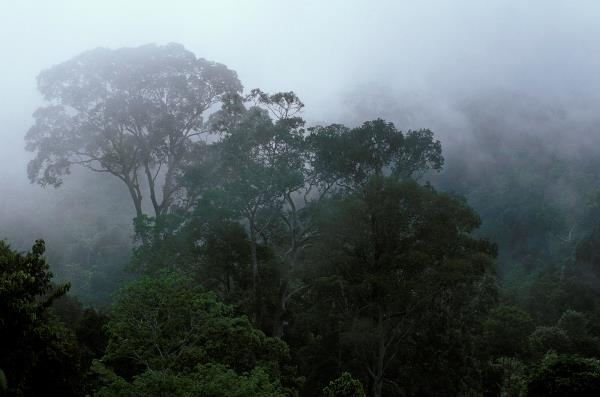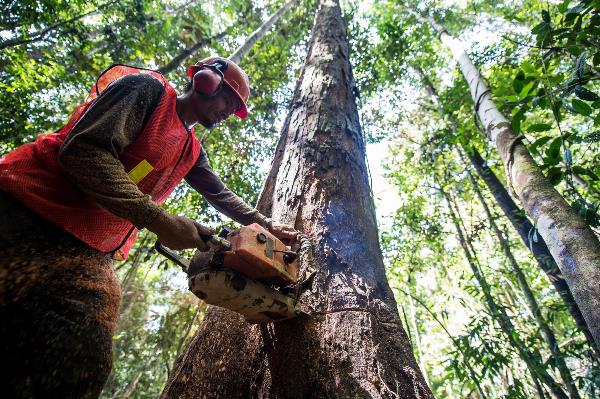The Study: Griscom, B., P. Ellis & F.E. Putz. 2014. Carbon emission performance of commercial logging in East Kalimantan, Indonesia. 2014. Carbon emissions performance of commercial logging in East Kalimantan, Indonesia. Global Change Biology, 20:3. doi: 10.1111/gcb.12386
The Big Question: Several existing studies have determined that reduced impact logging (RIL) — a set of logging practices that aims to take only high-value timber from forests while minimizing the impact to surrounding ecosystems and communities — can reduce carbon emissions under experimental conditions. (That’s important because 10% of the world’s carbon emissions come from tropical deforestation and forest degradation.)
The question Bronson Griscom, the Nature Conservancy’s director of forest carbon science, set out to answer in this paper was: Do they in actual practice and at a landscape scale? And…oh yeah…how can that be verified without breaking the bank?
Study Nuts and Bolts: Typically, scientists measure carbon emissions from logging by randomly locating a series of plots across a concession. “But the problem with that approach,” says Griscom, “is that you spend a lot of time measuring things that don’t tell you about logging performance.”
Instead, Griscom and colleagues went where the logging action was actually happening. Using GPS devices, they tracked the paths of bulldozers and the locations of stumps in nine commercial logging concessions in eastern Indonesia.
Every tree that is cut down or damaged in a logging operation and not turned into usable wood represents an avoidable source of carbon emissions. So the researchers measured the width of trails and roads and the mass of trees destroyed to open them.
Taking big tropical trees out of a crowded forest can involve a lot of collateral damage, so the researchers estimated the number and size of trees damaged or killed when taking down the intended tree — whether crushed by a falling tree, dragged down by the vines that knit one tree to another, or pushed over by a bulldozer blade.
Adding all these sources together gives a good estimate of the carbon emitted by a logging operation—and it takes about 10 percent of the time required by the random-plot method.

The Findings: The authors had expected to find that concessions claiming to practice reduced impact logging (RIL) would have lower carbon emissions. To their surprise, they found no difference in carbon emissions between RIL and conventional concessions.
The authors identified four practices that do improve emissions performance, but they are not all recognized as RIL and not applied consistently, even on RIL concessions. If implemented together, these four practices could reduce carbon emissions from logging in Indonesia by about 50 percent, without reducing wood production.
Looking deeper into these inconsistencies, the authors describe a system in which the potential for carbon savings gets hijacked by conflicting incentives.
One of the greatest opportunities for reducing the amount of carbon emitted per unit of useful wood harvested would be to leave hollow trees standing. Alive and standing, these old giants are ecologically important and continue to tie up carbon. Once cut, they simply rot on the forest floor. Unusable trees account for almost one-third of the wood cut on most concessions – and it’s easy to identify them before cutting – but chainsaw operators get paid by the tree felled, not the tree harvested, so unnecessary felling persists.
Pulling tree trunks out of the forest on long cables attached to winches leaves almost no damage along the skid paths. But the bulldozers that are typically used to pull harvested trees out of the forest clear a path at least 12 feet wide to each harvest tree. Winching is harder to detect, so it has become popular with illegal loggers and has been banned from legal use.
Directional felling—that is, deliberately putting a tree down where it will do less damage to noncommercial trees—is a common practice on RIL and conventional concessions. But focusing on the number of trees damaged, rather than the total mass of trees damaged led to missed opportunities for carbon savings.
RIL practices aren’t explicitly designed to reduce carbon emissions, so perhaps it’s not fair to expect them to, but focusing on measured carbon outcomes points to important gaps in existing reduced impact logging schemes.
What It All Means: Once implemented, the global payment system known as REDD+ could provide incentives for better logging practices under climate agreements. REDD+—or other voluntary payments—could help fund the transition to lower impact and more sustainable logging practices. But purchasers of emissions credits need to have confidence that they represent real carbon reductions — and concessionaires need low cost and accurate methods to document performance.
The method detailed in this study, Griscom says, offers an inexpensive alternative to traditional methods for documenting carbon emissions. It also highlights the need to establish a set of RIL practices explicitly focused on forest carbon losses that would tell carbon markets and climate-conscious consumers exactly what they were getting. “If our assessment of avoided emissions is higher than what’s real,” says Griscom, “that undermines the forest solution to climate change.”




Do you have any Forest Carbon Model related paper published?
Hi Nim, You can see a list of Bronson Griscom’s publications (including many on forest carbon) here – be sure to click on the Publications tab: http://www.nature.org/science-in-action/our-scientists/bronson-griscom.xml